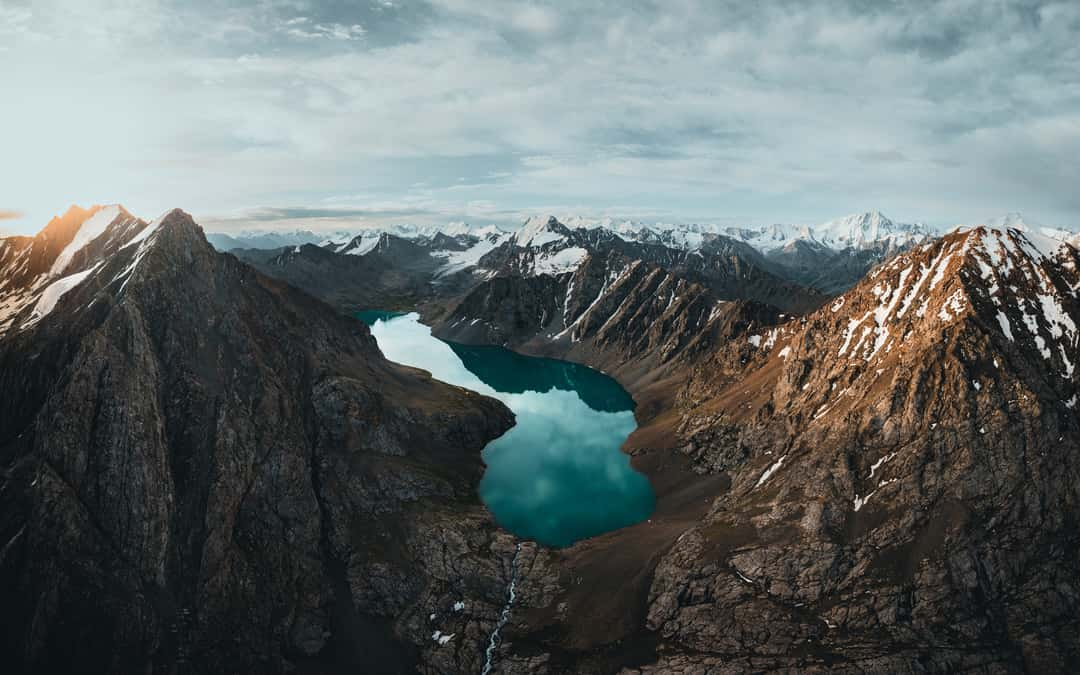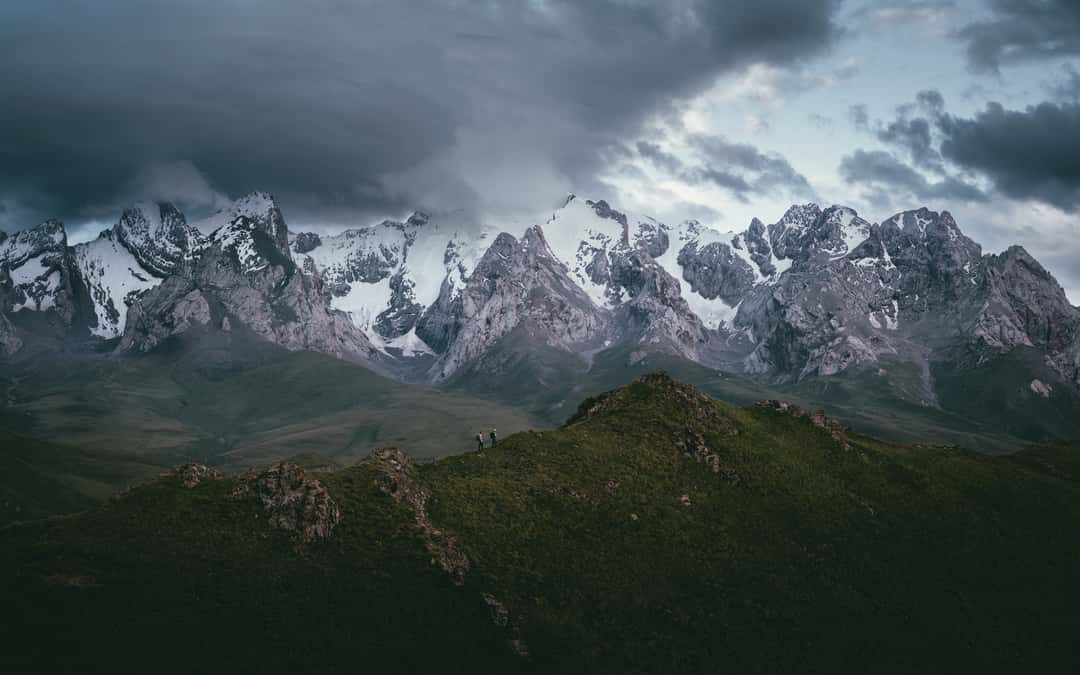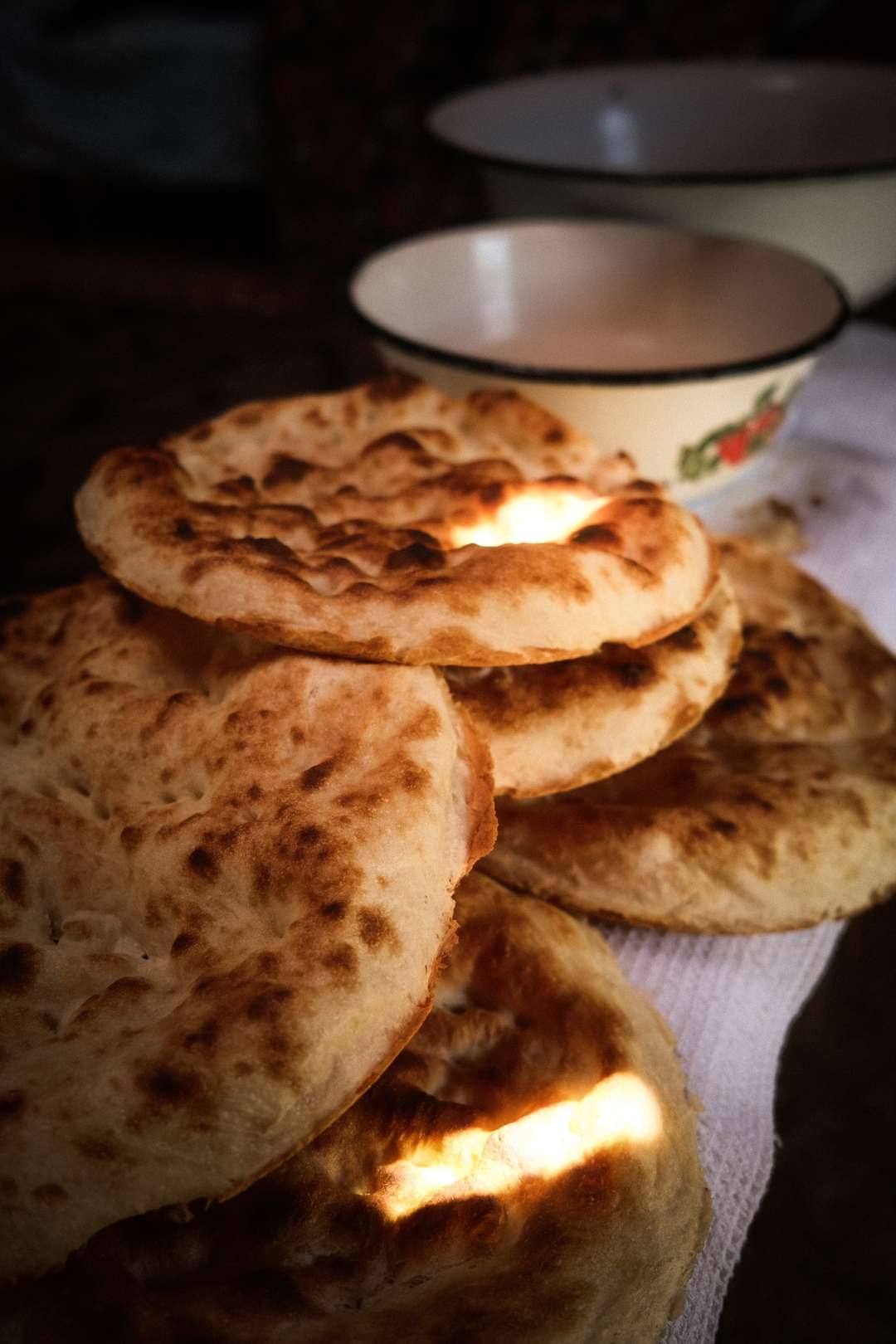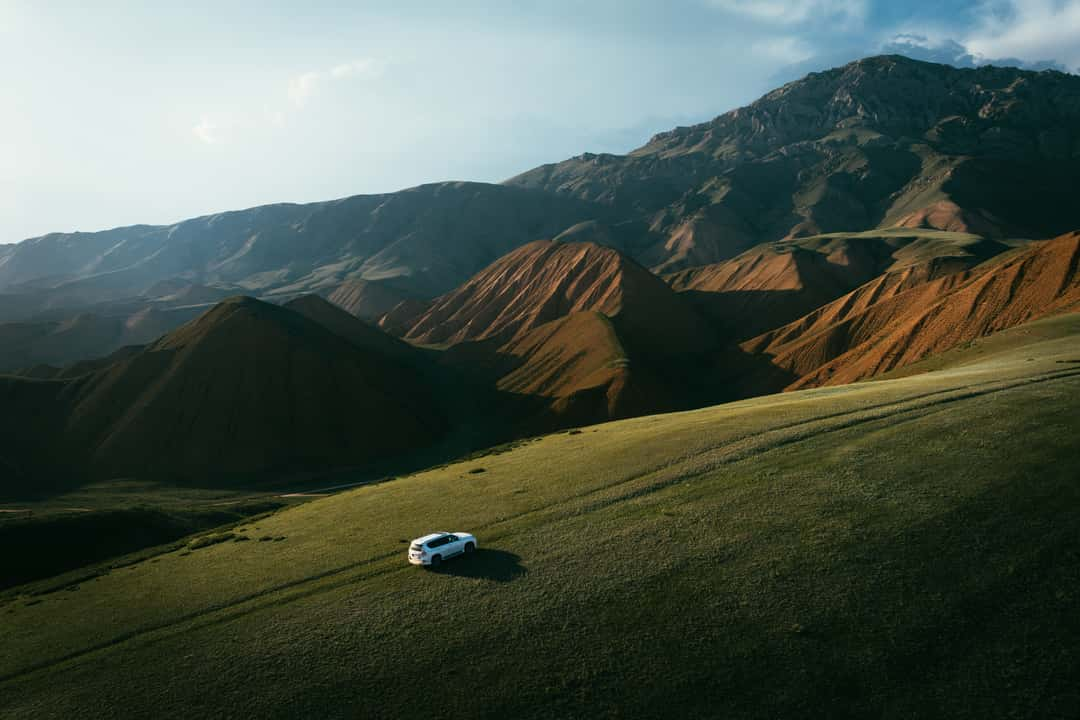Let's travel to Kyrgyzstan! - "Where? Where is that anyway, and what makes the country special? Is it safe there?" This was roughly how the first conversation between my twin brother and photo buddy Sebastian and I went before we fell in love with the republic during our trip.
Known for its traditional nomadic lifestyle, this mountainous country is characterized by a diverse culture that brings every trekking enthusiast a little closer to the feeling of freedom. The post-Soviet country is surrounded by Kazakhstan, China, Tajikistan, and Uzbekistan, offering a rich mix of seemingly endless steppes, stunning turquoise mountain lakes, mysteriously shaped deep red canyons, lush green forests with cascading roaring waterfalls, and, above all, almost untouched mountain passes and ranges.
1. What are some of the most iconic landmarks or places to photograph in Kyrgyzstan?
1.1 Most popular
Son Kul Lake: The largest freshwater lake in the country, stretching 29 kilometers and situated at an altitude of over 3,000 meters above sea level, is especially known for its rich traditional nomadic culture. Time seems to pass differently here, as shepherds drive their cattle and horse herds to the lush high pastures in May and June to sustain their pastoral lifestyle and set up their round, felt-covered yurts. Visitors can experience the nomadic culture up close, whether by spending the night in one of the yurt camps or, with a bit of luck, through an invitation from a farmer riding up at dawn. Using hand gestures, he may invite you to his farm, pour tea, and offer a taste of his homemade bread.

Get the exact geo-position for this spot: Nomad life at Lake Song-Kul
Kell-Suu Lake, Naryn Region: Formed by a powerful earthquake, this approximately 11-kilometer-long lake lies in the source rivers of the Kurumduk River in the Kokshaal-Too Mountains at an elevation of around 3,514 meters above sea level and is considered one of the most beautiful in the country. Surrounded by steep, dramatic mountain walls, the greenish-hued lake can even be crossed by small motorboats. About 6 kilometers away, yurt camps offer simple accommodations with freshly prepared meals. Camping in your own tent is also possible, though the frequent storms pose some risk. For those adventurous enough to explore, the area beyond the lake offers a variety of undiscovered hiking trails. The result is untouched nature and countless breathtaking views.

Get the exact geo-position for this spot: Kel-Suu area, South Thian Shan
Karakol Area: Located in the east of the country, the city of Karakol boasts the best-developed infrastructure compared to the rest of Kyrgyzstan, offering tourists a wide range of opportunities to immerse themselves in nature and the nearby mountain ranges. One of the most popular activities is the Ala-Kol Trek, which takes 3 to 4 days depending on the chosen route and camps. The trek's highlight is the Ala-Kol Pass, offering a breathtaking view of the emerald-blue Ala-Kol Lake, surrounded by snow-covered mountains and glaciers.

Get the exact geo-position for this spot: Ala-Kul Lake, Oblus Yssyk-Köl
1.2 Hidden Reachable Gems
Canyon of Forgotten Rivers: In the southern part of Lake Issyk-Kul, known as the "Pearl of Central Asia" and the second-largest mountain lake in the world, a seemingly modest, unpaved path near the small town of Bokonbaevo leads to the lake’s coastal fringes. After a short distance, the scenery abruptly transforms, and you find yourself surrounded by serpentine, uniformly shaped, deep red sedimentary rocks that rise in layers, forming the heart of the canyon.

Get the exact geo-position for this spot: Panorama view, Ak-Sai Canyon
The true beauty of this site is revealed at a viewpoint overlooking the canyon, which explains its evocative name, "Canyon of Forgotten Rivers." The landscape resembles hundreds of dried-up, wandering rivers that, over centuries, carved their way through the rock, following the path of least resistance.
Sary-Jaz Valley: Located off the well-trodden paths, this valley exudes a unique charm of its own. After a challenging journey over several mountain passes and passing through two military checkpoints requiring special permits, visitors are rewarded with an epic mountain panorama.

Get the exact geo-position for this spot: Camping in Sary-Jaz valley
The vast, tranquil steppes, traversed by a wide glacial river, are beautifully framed by the Tien Shan Mountains, whose snow-covered peaks often soar above 6,000 meters. This is a place where one can experience profound tranquility amidst untouched nature.
2. Preparation
2.1 Which Seasons Are Best for Photography in Kyrgyzstan? What Is the Weather Like?
Kyrgyzstan has a strongly continental climate. After a very cold winter, a hot summer often follows, with early summer (March to May) being the most likely to bring rain. In general, the country is very accessible for travel between May and September, but it largely depends on your interests.
Since 90% of the country consists of mountains, you need to decide whether exploring the lower regions (below 2,500 meters above sea level) suffices or if you want to venture into the high plateaus. If you plan to experience both, the best time to visit is likely between July and August.

Get the exact geo-position for this spot: South Tian Shan Mountain Range, Rajons At-Baschy
While temperatures in the capital, Bishkek, can quickly rise above 30°C, mountain valleys typically see temperatures of around 20–25°C, and at altitudes of 3,000 meters, they drop to around 15°C. However, nighttime temperatures can differ significantly, often approaching freezing.
It is worth noting that even in July, some mountain passes might still be closed due to the ongoing impacts of climate change. During our travels in July, we experienced nearly every type of weather on a daily basis. Therefore, it’s crucial to always be prepared for various conditions when undertaking hikes or trekking tours, with warm and waterproof clothing in your gear.
Ultimately, weather conditions vary greatly depending on the region and altitude. It’s essential to keep an eye on the weather forecast before choosing a destination or embarking on a mountain excursion.
2.2 How to Prepare for a Visit to High-Altitude Areas
The term "high-mountain country" should grab your attention. Upon arriving in the capital, Bishkek, by plane at an altitude of 800 meters, and traveling onward toward Issyk-Kul, the largest lake, you will already be at twice that elevation. Cities like Karakol are also situated at 1,600 meters, and Naryn is just under 2,000 meters. These altitudes are generally unproblematic for the human body.
However, if you plan to explore the high plateaus of various mountain regions, the elevation often exceeds 3,000 meters. For example, the aforementioned Kel-Suu Lake is situated at 3,500 meters, and the highest pass near Ala-Kul reaches approximately 4,000 meters.

Get the exact geo-position for this spot: View to Ontor Glacier and Karakol Peak
It is well known that there is a risk of altitude sickness above 2,500 meters. As altitude increases, air pressure decreases, resulting in less oxygen reaching the lungs, and consequently, a lower oxygen content in the blood. This reduces metabolic activity, potentially causing symptoms like dizziness, headaches, nausea, fever, or shortness of breath.
It is important to allow the body time to properly acclimatize. Once adapted to the altitude, the body produces more hemoglobin and regulates metabolism again. This process generally works well, especially since the cities mentioned earlier are not located at 3,000 meters.
To aid acclimatization, it’s helpful to drink plenty of water and consume sweet or salty foods (e.g., candy, cola) to maintain electrolyte balance. A healthy diet supports faster digestion, while fats and proteins consume more oxygen during processing. Avoiding alcohol is highly recommended, as it dehydrates the body.
Each person should listen to their own body, be mindful of warning signs, and take the time necessary to fully enjoy the different tours.
2.3 Medication
A healthy, balanced diet and sufficient hydration are the best medicine to ensure you can enjoy your mountain tours without experiencing health issues. In extreme altitudes, however, it’s always advisable not to linger too long and to begin your descent after an appropriate amount of time. Opting for a lower-altitude campsite is also recommended if you are using your own tent.
It’s essential to carry a general first-aid kit with you at all times while in the mountains. Additionally, we always bring emergency medications such as painkillers like ibuprofen, remedies for headaches, gastrointestinal issues, or constipation.
Before visiting Kyrgyzstan, you can find all the important health-related information on the website of the Foreign Office.

Get the exact geo-position for this spot: Unnamed mountain, Tian Shan
2.4 Budget and Finances (Cost of Dinner, Payment Methods, Currency)
The currency in Kyrgyzstan is the Som, with 1 Euro equaling approximately 100 Som, depending on the exchange rate. According to studies, the average income of citizens currently amounts to around 340 Euros. However, the standard of living in the capital, Bishkek, is significantly higher than in other parts of the country, and higher expenses should be expected there.
Compared to Germany, you can plan for a much smaller budget for living costs. In the summer of 2024, we spent an average of around 20 Euros per person per day. This covered all meals, drinks, and a simple place to sleep.

Traveling by public transportation in the form of minibusses costs between 2.5 Euros and a maximum of 10 Euros for several-hour trips. However, we recommend booking a rental car, organizing a private driver if traveling with multiple people, or using a mix of public transportation and private drivers. You can book a private driver for individual routes or for 2-3 days, depending on the region.
Prices vary greatly depending on the popularity of the region, but on average, you can expect to pay around 100 Euros per day. This includes the cost of fuel, driver accommodation, and meals. It’s also possible to negotiate the price. If you want to visit regions that are particularly difficult to access, where few drivers offer this service, the price can quickly triple. For safety reasons, you won’t travel alone in these cases; you’ll either drive with two cars or travel in a group, which justifies the higher price.
For a four-week round trip (as of July 2024), you can expect to budget around 560 Euros for living expenses. The cost of transportation depends on individual needs.
Important: Cash is often essential, especially in mountain regions! As soon as you are just a few meters outside the city, the connection network breaks down. There is no reception or internet, so payments can only be made in cash. Many cities have ATMs where you can withdraw money without issue. Be sure to check with your bank in advance and, if necessary, unlock your cards for use in the country.
3. Photography Equipment
3.1 Camera Recommendation
Basically, every photographer or photography enthusiast should ask themselves what type of photography they aim to pursue and what their intentions are.
-
Canon RF 24-70mm f2.8, main lens during the hikes. It covers a good range of focal lengths, offers a photographic style that is most familiar for people, is quickly accessible when attached to the buckle of the backpack with the appropriate mount, without putting too much weight on one side, and is perfect for spontaneous shots.
-
Canon RF 100-500mm f4.5-7.1, my favorite. Fortunately, I chose this lens over the RF 70-200 f2.8. The weight is, of course, not ideal for the mountains, but the completely new perspective it offers in the mountains truly pays off. Given the vast distances between the mountains and mountain ranges on the plateaus, I was still able to capture great shots of individual distant yurts, shepherds on horseback in the golden morning light, or single mountains in an alpine glow. It was also very beneficial for wildlife photography, as it allowed me to maintain a respectful distance from animals like dholes or yaks.
-
DJI Mavic 3 Pro Drone. Especially at key points during hikes, the drone was very useful for capturing the vastness and dimensions of the landscape from the air. The panoramic function for photos was also ideal for creating a sense of space with people in the frame, giving the viewer an impression of the immense landscape. Additionally, there are no specific laws outside of cities regulating drone usage, so one can avoid many of the rules and no-fly zones that exist in Europe or many other countries around the world.

Before each hike, it's important to carefully consider what you hope to capture at the location and how long the tour will last. For example, if you're going on a day hike, you can easily rely on your photo backpack, pack it with enough water and food, and bring all of your equipment. However, for a multi-day trekking tour, it's essential to set priorities. For instance, I always opted not to bring a second camera body or a small compact camera, and I also left out the tripod. It also depends on the weight capacity of your trekking backpack and what other functional items you are carrying, based on size and weight.
It can be helpful to coordinate with your companion so that each person brings a different focal length on the tour and share the cameras. Of course, it's an advantage if you’re familiar with each other's systems, or ideally, use the same system.
For portraits of locals, it can be beneficial to carry a small, compact camera. People with limited contact with tourists are often intimidated or scared by larger cameras. Also, try to build a rapport or connection with the person before photographing them, and take your time if you're interested in this type of photography.

4. Important to Know
4.1 How to Travel Safely in Kyrgyzstan?
The post-Soviet country has been independent since 1991. Initially, EU citizens can enter Kyrgyzstan without a visa for up to 60 days. The official languages are Russian and Kyrgyz. English is almost not spoken outside the capital. Due to the long-standing Russian influence on the country and its geographic proximity to China, Kyrgyzstan maintains a neutral stance on current political conflicts, including the recent Russian invasion of Ukraine. Russia has been a popular destination for education and emigration for many Kyrgyz people. At the same time, some Russians use Kyrgyzstan to escape recruitment. Russian propaganda through television channels is also widespread. However, there is some fear that the great power of China may seek to exert more influence on the country. In the border areas with China, there are strictly controlled military checkpoints. As a tourist, you can only enter these areas with permits issued by the government. Additionally, the Foreign Office advises against traveling to the southern part of the country, especially in the border region with Tajikistan, due to the presence of some terrorist Islamic cells, which are regularly dismantled by the government.
Generally, the safest mode of transportation is a rented car, a personal driver who speaks the official language, or public transportation in the form of buses. Recently, a railway network has started to be built, with the first longer stretch officially opened in September 2024.

Get the exact geo-position for this spot: Red hills near Naryn
If you rent a car, it’s advisable to always rent full insurance due to the poor road conditions and to ensure the car comes with a spare tire. You should also have knowledge of how to change a tire yourself. During our four-week trip, we had several flat tires. Local workshops can also fix the tire for a small fee.
In the mountains, you also have the option of taking advantage of the many services offered by nomads who settle there in the summer, such as traveling longer distances on horseback. You can often book these tours through your Airbnb, accommodations, or hostels. The owners are usually well-connected with other families and always have options available. This also applies to tour guides for multi-day hiking routes.
If you're traveling alone or with companions without a mountain guide on hikes or multi-day trekking tours, you should always keep an eye on the weather and its changes. It’s best to make a checklist and go through it specifically for each tour. It’s recommended to pack using the layering system and be prepared for all weather conditions, especially since we experienced very unpredictable weather in Kyrgyzstan, and the mountain regions are often hard to predict. Additionally, always carry enough water and food with you.

Get the exact geo-position for this spot: Glacier river crossing, Kakschaaltoo Mountain Range
A small emergency kit with medications and bandages, a flashlight or headlamp, a multitool with a knife, and an emergency whistle are also important. The latter is now often integrated into the top loop of backpacks. For multi-day tours, it’s advisable to bring a water filter. Generally, the spring water from the many glacial streams is safe, and in the respective camps, you can refill your water for a small fee.
4.2 How to Overcome the Language Barrier?
If you don't speak Russian or Kyrgyz, communication can be quite difficult. At the very least, it's a good idea to learn or save some key phrases in Russian before your trip to enable basic communication. Offline translation tools can also be helpful for getting by, which you can download from the app store on your smartphone. Some drivers, for example, also have voice recorders with translation functions.
Otherwise, you'll have to rely on gestures, a friendly smile, or a kind gesture to communicate.

In cities, the internet and various translation apps can help you communicate through your phone. So, make sure to get a mobile data plan or a SIM card that allows you to use these services when needed. These are especially cheap to buy at the airport. For example, as of July 2024, an unlimited data plan for one month cost around five euros. On the other hand, this is only available in cities, where you generally don't spend much time.
4.3 What Are Some Cultural Aspects to Consider When Photographing in Kyrgyzstan?
In terms of cultural aspects related to photography, there aren't any specific rules to be aware of. However, it's much more important to adhere to the strict regulations at military checkpoints. Photography is strictly prohibited there, and this rule must be absolutely followed. Failure to do so can lead to serious problems.
People in Kyrgyzstan, particularly in the mountain regions, are often camera-shy, as they are simply not used to being photographed or owning such equipment. When taking portraits of people, it's essential to engage with them first, build a connection, and kindly ask for permission or gesture towards taking the photo. Rejection should always be respected. It often helps to have a few previous photos on hand to show them, which can help ease the situation.
5. The Biggest Mistakes to Avoid When Traveling to Kyrgyzstan
-
Altitude sickness: Due to the many high mountains in Kyrgyzstan, it's important to acclimate beforehand to minimize the risk of altitude sickness. Helpful tips on this can be found under point 2.2!
-
Always keep an eye on the weather: Before any planned mountain tour, it's advisable to get an update. It's especially important to be prepared for any weather conditions and pack accordingly for day or multi-day trips, even if that means carrying more weight. We experienced very changeable weather every day in the mountains and were very glad we recognized this early on and were properly equipped in the following weeks. Bad weather in the mountains, especially in summer, can lead to landslides or flooded rivers, so be particularly careful.
-
Satellite phone: If you decide to embark on tours in truly remote mountain areas, it's advisable to carry a satellite phone. It’s also helpful to inform the military border controls about your location and hiking spot, so they can be prepared for a radio call and have received prior information. Before each tour, you should always inform someone about your route in general. This adds an extra layer of safety when someone is aware of your plans.
-
Lack of knowledge about tire changes / dealing with getting "stuck": Before booking a rental car, check if the rental company provides cars with spare tires. Also, make sure you carry all the necessary tools for a tire change and research how to do it online beforehand. A shovel should always be carried with you when traveling on many unpaved roads, especially if you’re at risk of getting stuck. It's also a good idea to inform yourself in advance on how to best free a car from being stuck.

-
Cashless travel: Once you leave the cities, you’ll be dependent on cash. Outside of cities, there is no reception, so cash is essential. It’s also possible that random police checks may occur if you're traveling in a rental car—this could be related to corruption. It’s advisable to keep some cash separate from your main stash to help you get through a check quickly.
-
Language barrier: Russian and Kyrgyz are the official languages and are widespread, while English is not. The language is still spoken very little, so it’s advisable to learn the basic words in one of the two languages or at least save them in a note. Offline translators / apps could also be helpful.
-
Develop an awareness of Kyrgyz cuisine: Kyrgyz food is predominantly based on meat and dairy, which can make traveling difficult for vegetarians. Therefore, for longer trips/routes outside of cities, it’s recommended to organize some extra provisions like noodles, vegetables, nuts, or bread from supermarkets in advance, so you won’t face any problems in the mountain regions or at nomad camps.





Comments (2)